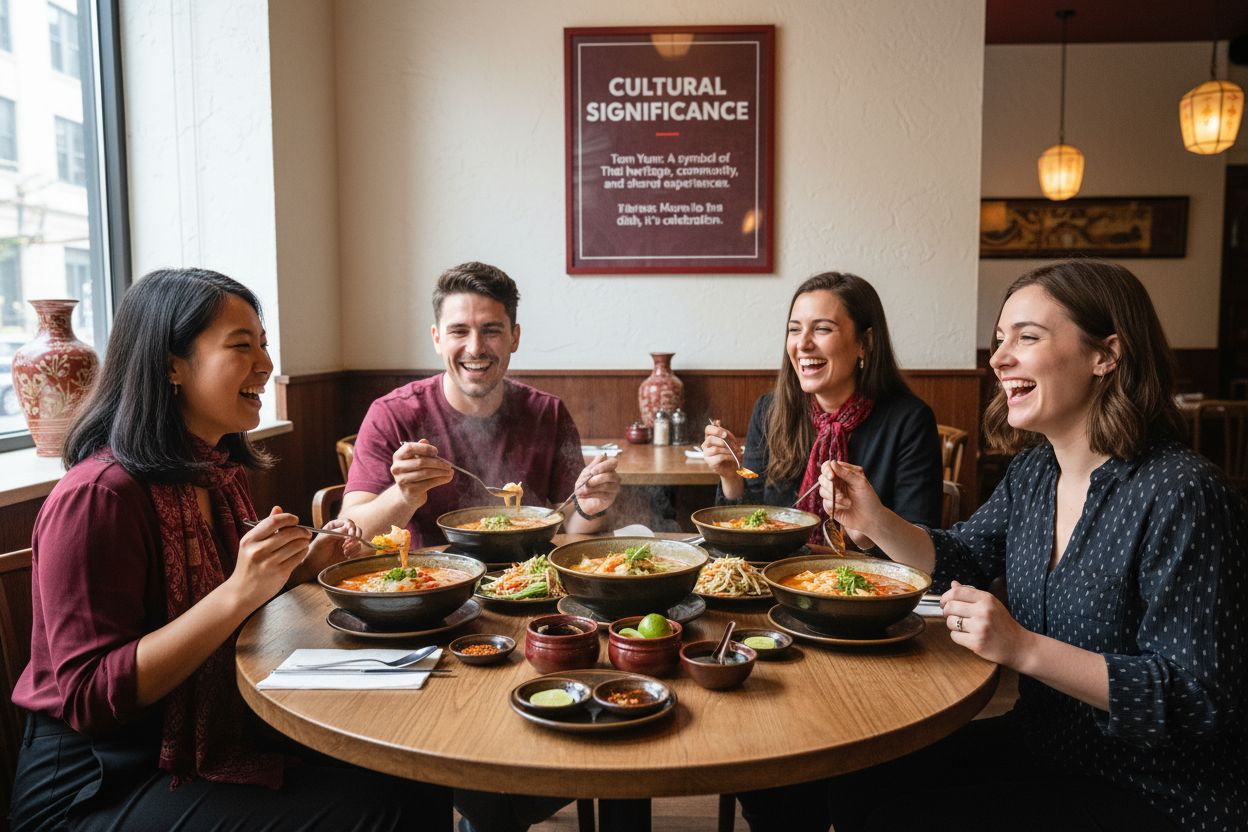What is Tom Yum Soup? Understanding This Flavorful Dish
- mail469793
- Oct 12
- 9 min read

Tom yum soup looks like a simple bowl of broth at first glance. Yet this Thai staple packs a punch that leaves most Western soups in the dust. Scientific studies reveal tom yum stimulates more taste receptors than almost any other soup, creating a four-dimensional flavor experience with every spoonful. This might sound overwhelming. But what truly sets tom yum apart is how each complex layer stays perfectly balanced, making every bite both bold and surprisingly harmonious.
Table of Contents
Quick Summary
Takeaway | Explanation |
Tom yum soup balances multiple flavors | The soup combines sour, spicy, aromatic, and umami elements for a complex taste experience. |
Cultural significance enhances the dish | Tom yum reflects Thai values of balance, harmony, and communal sharing, making it more than just a meal. |
Every ingredient has symbolic meaning | Ingredients like lemongrass and chilies carry cultural significance, contributing to the soup’s depth beyond flavor. |
Global adaptations retain core elements | Variations worldwide respect tom yum’s original flavor profile while incorporating local ingredients and tastes. |
Preparation and consumption reflect social rituals | The act of making and enjoying tom yum embodies respect and connection among individuals and families. |
Understanding the Essence of Tom Yum Soup
Tom yum soup represents a quintessential representation of Thai culinary artistry, embodying a complex symphony of flavors that dance across the palate. Thai cuisine’s remarkable taste balance transforms this seemingly simple soup into a profound gastronomic experience that captures the heart of Southeast Asian cooking.
The Flavor Profile
At its core, tom yum soup is a masterpiece of culinary engineering, designed to stimulate every taste sensation simultaneously. The soup achieves its distinctive character through a carefully orchestrated blend of ingredients that provide multiple sensory experiences:
Sour: Typically achieved through lime juice or tamarind
Spicy: Delivered by fresh chilies or chili paste
Aromatic: Developed through lemongrass, kaffir lime leaves, and galangal
Umami: Enhanced by shrimp, fish sauce, or protein
These elements combine to create a broth that is simultaneously bright, intense, and deeply satisfying. The soup challenges Western palate expectations by presenting a multi-dimensional flavor experience that goes far beyond traditional soup constructs.
Cultural Significance
Beyond its remarkable taste, tom yum soup represents more than just a meal preparation. It embodies the Thai culinary philosophy of balance and harmony, where no single flavor dominates but instead interacts dynamically. Whether prepared with shrimp, chicken, or as a vegetarian variant, the soup remains a testament to the sophisticated approach of Thai culinary traditions.
The soup’s adaptability reflects the cultural understanding that food is not merely sustenance but a form of artistic expression, communicating complex emotions and cultural narratives through carefully selected ingredients and precise preparation techniques.
The Cultural Significance of Tom Yum in Thai Cuisine
Thai cuisine culture represents a profound narrative of culinary storytelling, with tom yum soup standing as a powerful symbol of national identity and gastronomic heritage. This beloved dish transcends mere nutrition, embodying generations of cultural wisdom and social connection.
More Than Just a Soup
Tom yum represents a complex cultural artifact that communicates deeply about Thai social dynamics and philosophical approaches to food. The soup is not simply a meal but a reflection of Thai values of balance, harmony, and communal sharing. Its preparation and consumption involve intricate social rituals that demonstrate respect, hospitality, and familial connection.
Symbolic Ingredients and Meaning
Each ingredient in tom yum carries symbolic significance beyond its flavor profile. According to research from Mahidol University, the soup’s components represent fundamental aspects of Thai cultural philosophy:
Lemongrass: Symbolizes resilience and adaptability
Kaffir Lime Leaves: Represents purification and spiritual cleansing
Chilies: Signifies passion and emotional intensity
Shrimp: Represents local maritime heritage and community connectivity
These ingredients are not randomly selected but carefully chosen to create a holistic sensory experience that connects individuals to their cultural roots. The soup becomes a medium of cultural transmission, allowing younger generations to experience traditional flavors and understand their culinary lineage.
To help clarify the significance of each ingredient in tom yum soup, the following table summarizes their roles and symbolic meaning in Thai culture.
Ingredient | Flavor Role | Symbolic Meaning |
Lemongrass | Adds citrusy, woody aroma | Resilience and adaptability |
Kaffir Lime Leaves | Provides intense fragrance | Purification and spiritual cleansing |
Chilies | Introduces heat and spice | Passion and emotional intensity |
Shrimp | Adds umami and sweetness | Maritime heritage and community connectivity |
Fish Sauce | Deepens umami and saltiness | Culinary depth (not assigned a symbolic trait) |
Galangal | Adds warmth and peppery complexity | Not specified |
Lime Juice | Delivers sharp acidity | Not specified |

Moreover, tom yum serves as a culinary ambassador, introducing global audiences to the complexity and sophistication of Thai gastronomy. Its international popularity has transformed it from a local dish to a global representation of Thai cultural excellence, demonstrating how food can transcend geographical boundaries and create cross-cultural understanding.
Key Ingredients that Define Tom Yum Soup
Tom yum soup emerges as a culinary masterpiece through its meticulously selected ingredients, each playing a crucial role in creating its distinctive flavor profile. Thai spice expertise transforms these components into a harmonious gastronomic experience that tantalizes the senses.
Essential Aromatic Herbs
The foundation of tom yum’s remarkable taste lies in its aromatic herbs, which provide layers of complexity and depth. Lemongrass, with its citrusy and slightly woody notes, serves as a fundamental ingredient that imparts a bright, refreshing undertone. Kaffir lime leaves contribute a unique, intensely fragrant essence that cannot be replicated by any other ingredient. Galangal, a rhizome similar to ginger but with a sharper, more peppery profile, adds a distinctive warmth and complexity to the broth.
Protein and Umami Components
Proteins in tom yum are not merely an afterthought but a critical element of its flavor composition. According to scientific research, the ingredients contribute significant health benefits beyond their taste:
Shrimp: Provides a rich umami foundation and maritime sweetness
Fish Sauce: Delivers intense saltiness and depth of flavor
Mushrooms: Offer an earthy undertone and additional nutritional value
Chili Peppers: Introduce heat and stimulate metabolic processes
Balancing Flavor Agents
The final layer of tom yum’s complexity comes from its balancing ingredients. Lime juice brings a sharp, bright acidity that cuts through the richness of the broth, while fresh chilies contribute a dynamic heat that evolves across the palate. These components work in concert, creating a soup that is simultaneously complex, refreshing, and deeply satisfying. The delicate balance represents the pinnacle of Thai culinary philosophy, where no single flavor dominates but instead creates a harmonious whole.
Flavor Profiles: What Makes Tom Yum Unique?
Understanding authentic Thai flavors reveals the extraordinary complexity of tom yum soup, a culinary creation that defies traditional Western flavor expectations. This soup represents a sophisticated interplay of taste sensations that challenge and intrigue the palate.
The Four-Dimensional Taste Experience
Tom yum’s uniqueness stems from its deliberate orchestration of four fundamental taste dimensions. Unlike Western soups that often focus on a single dominant flavor, tom yum creates a simultaneous sensory dialogue. Sour notes from lime juice provide a sharp, bright foundation. Spicy elements from fresh chilies introduce a dynamic heat that evolves across the tongue. Salty undertones from fish sauce create depth, while subtle sweet nuances emerge from fresh ingredients like shrimp or chicken.
Sensory Complexity and Balance
The soup’s flavor profile is not merely about individual ingredients but their intricate interactions.
INFOGRAPHIC:infographic_content] According to [scientific flavor research, tom yum exemplifies a culinary technique where ingredients are carefully selected to create a harmonious yet complex taste experience:
Herbal Aromatics: Create initial sensory engagement
Protein Base: Establishes umami foundation
Acidic Components: Provide brightness and balance
Spice Elements: Generate dynamic heat progression
Psychological and Physiological Impact
Beyond taste, tom yum’s unique profile triggers fascinating psychological and physiological responses. The soup’s complex flavor combination stimulates multiple sensory receptors simultaneously, creating a holistic eating experience that goes beyond simple nutrition. The interplay of heat, acidity, and aromatic herbs generates a sensory journey that awakens the palate, stimulates metabolism, and provides a profound sense of satisfaction that extends far beyond ordinary culinary encounters.
Exploring Variations of Tom Yum Soup Around the World
Thai culinary traditions demonstrate remarkable adaptability through tom yum soup’s global transformations, revealing how a single dish can evolve while maintaining its core culinary identity. The soup’s journey across international borders showcases its extraordinary versatility and universal appeal.
Regional Adaptations
Each region introduces unique interpretations that respect the original tom yum’s foundational principles while introducing local ingredients and cooking techniques. In Southeast Asian countries, variations emerge based on local protein availability and cultural preferences. Malaysian versions might incorporate more coconut milk, creating a creamier texture, while Vietnamese adaptations often feature additional herbs like Thai basil and sawtooth coriander.
Global Culinary Interpretations
According to global food research, tom yum has undergone fascinating transformations in different culinary contexts:
North American Version: Often features additional vegetables like bell peppers
European Adaptation: Frequently incorporates local seafood like mussels
Australian Interpretation: Tends to use more indigenous herbs and spices
Japanese Fusion: Sometimes prepared with lighter, more delicate broths
Maintaining Authentic Essence
Despite these global variations, successful tom yum adaptations share a critical characteristic: they preserve the soup’s fundamental flavor profile of sour, spicy, salty, and aromatic elements. Chefs worldwide recognize that tom yum’s magic lies not in rigid adherence to a single recipe, but in capturing its vibrant, dynamic spirit. The soup becomes a culinary canvas, allowing creative interpretation while maintaining its fundamental Thai gastronomic philosophy of balance and complexity.
The table below compares regional and global variations of tom yum soup, highlighting how different cultures adapt the dish while maintaining its core elements.
Variation/Region | Distinctive Adaptation | Maintained Core Elements |
Malaysia | Adds coconut milk for creaminess | Sour, spicy, and aromatic flavors |
Vietnam | Uses extra herbs (Thai basil, coriander) | Bright, herbal, and spicy notes |
North America | Includes more vegetables (bell peppers) | Core sour and spicy broth maintained |
Europe | Uses local seafood like mussels | Preserves aromatic and umami elements |
Australia | Incorporates indigenous herbs and spices | Retains original balance of flavors |
Japan | Employs lighter, delicate broths | Keeps aromatic and umami layers |
Discover True Tom Yum Flavor in Las Vegas
Are you craving the bold, balanced flavors of authentic tom yum soup after learning about its cultural richness and unique taste experience in our guide? Many Thai food lovers struggle to find a place that brings together the perfect combination of sour, spicy, aromatic, and umami elements described in the article. At Thai Spoon Las Vegas, we celebrate this iconic soup with genuine ingredients like lemongrass, galangal, and fresh chilies. Experience the harmony and depth that make tom yum a symbol of Thai culinary artistry—right here in your own neighborhood.

Ready to taste the complexity of real tom yum without compromising authenticity? Visit our menu to order online or see our vegan and gluten-free options. Enjoy this flavorful dish for pickup, delivery, or dine-in today. Authenticity and convenience are just a click away at Thai Spoon Las Vegas—we invite you to savor every spoonful and experience the true taste of Thailand. Do not wait. Treat yourself to the rich flavors and cultural depth of tom yum soup now.
Frequently Asked Questions
What are the main ingredients in tom yum soup?
Tom yum soup primarily includes lemongrass, kaffir lime leaves, galangal, shrimp or other proteins, fish sauce, chilies, and lime juice. Consider gathering these ingredients to prepare an authentic version of the soup at home.
How does the flavor profile of tom yum soup differ from other soups?
Tom yum soup is characterized by a unique blend of sour, spicy, salty, and aromatic flavors, creating a multi-dimensional taste experience. To truly appreciate its complexity, try tasting it alongside a traditional Western soup for comparison.
What is the cultural significance of tom yum soup in Thai cuisine?
Tom yum soup serves as a symbol of Thai culinary philosophy, representing balance, harmony, and communal sharing. Explore the preparation process to understand the social rituals tied to this dish.
How can I modify tom yum soup for dietary restrictions?
You can adapt tom yum soup to dietary restrictions by using alternative proteins like tofu for vegetarians or gluten-free fish sauce for those with gluten sensitivities. Experiment with different ingredients while maintaining the core flavor profile to cater to various dietary needs.
What are some popular variations of tom yum soup around the world?
Global versions of tom yum soup include adaptations with local ingredients, such as coconut milk or different seafood types, while still preserving its essential flavor elements. Try creating your own twist by incorporating local flavors while respecting the original flavor balance.
How do I achieve the right balance of flavors in tom yum soup?
To achieve the right balance of flavors in tom yum soup, focus on combining equal parts sour, spicy, and salty elements. Taste as you go, adding lime juice and chilies gradually to fine-tune the flavor, ensuring a harmonious and satisfying result.
Recommended









Comments